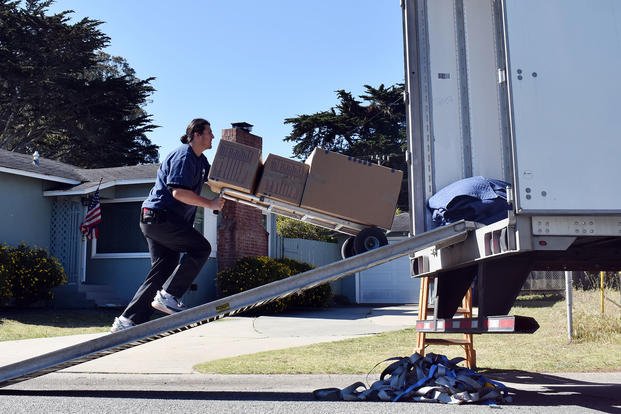
The Pentagon has directed the military services to cut the amount of money they spend on permanent change-of-station, or PCS, moves for troops in half by 2030 as part of an ongoing effort to reduce spending.
The services are tasked with cuts that amount to an initial 10% of the $5 billion PCS budget in 2027 and that increase annually -- hitting 50% by 2030, according to a May 22 memo that was publicly released Wednesday. The memo, by the under secretary of defense for personnel and readiness, says the services should target “discretionary move” budgets.
Pentagon leaders framed the push to cut those PCS moves as a way to reduce costs and provide stability for families. However, department officials did not offer clear definitions on what moves are discretionary and what guardrails will be put in place to keep the cuts from affecting families or careers.
Read Next: Pentagon Diverts $1 Billion from Army Barracks to Fund Border Mission[1]
Tim Dill, a top official in the Pentagon’s Office for Personnel and Readiness, told reporters that the department is giving the services four months to come up with plans to “reduce the frequency of PCS moves for service members, driving much needed efficiencies for the department and improving the quality of life for warfighters and military families.”
The memo charges each service to consider altering troop career pathways or just how many opportunities service members get to serve outside of their specialties.
Dill wants the service to “look at where is a move absolutely necessary to accomplish” giving troops “the right leadership opportunities,” and where “a move [is] not necessary to accomplish it.”
While the emphasis is being placed on “discretionary moves,” officials at the Pentagon on Wednesday struggled to define the term, and one explained it as moves that include operational travel inside the U.S., rotational travel to or from overseas, and individual service member training travel -- three categories that include a broad majority of military moves.
The memo and Pentagon officials stressed the outcome of the changes should be a boon for families, but they stopped short of offering guarantees on all possible scenarios.
The overall idea is also not entirely new. Several years ago, the Marine Corps made a push to offer more opportunities for families to stay put[2] for longer as part of an overhaul of its retention policies.
When asked whether a possible outcome of the new policy would be more family separations, given the tightening budget for moves, Dill said they were “not dictating the way in which this needs to be done and we would want to hear from the services, their concerns … about some of the examples you named.”
“We understand there's some risks associated with some of the methods,” Dill added.
Dill also pushed back on the idea that the new policy, framed as protecting military families, would result in single service members bearing the brunt of the burden to support jobs in less popular or less family friendly locations.
“This is not a policy where we just think we need to take the moves away from the families and put it on someone else -- it's for everyone,” he said.
Dill also said he is aware that some military locations are just broadly unpopular, and the department is “very open” to talking to the services about those dynamics. But Dill also said he thought “that there are service members out there that are perfect for any installation, but we want to make sure that where we can, we match up with service member preferences as much as possible.”
According to officials, cutting PCS moves is separate from another effort to address problems with the privatization of PCS household goods shipments[3] and shortcomings with the contractor that is taking over those shipments.
In a memo Tuesday to senior leaders and combatant commanders[4], Defense Secretary Pete Hegseth announced he ordered U.S. Transportation Command to address what he called "recent deficiencies" in performance by the company that manages the $7.2 billion contract to run the department's moving process.
Military families have reported numerous issues with scheduling and executing moves[5] that included issues such as packers not showing up, delayed pickups and deliveries, and surprise cancellations.
Related: Hegseth Orders Review of Defense Department's Support for Homeschooling[6]
© Copyright 2025 Military.com. All rights reserved. This article may not be republished, rebroadcast, rewritten or otherwise distributed without written permission. To reprint or license this article or any content from Military.com, please submit your request here[7].
